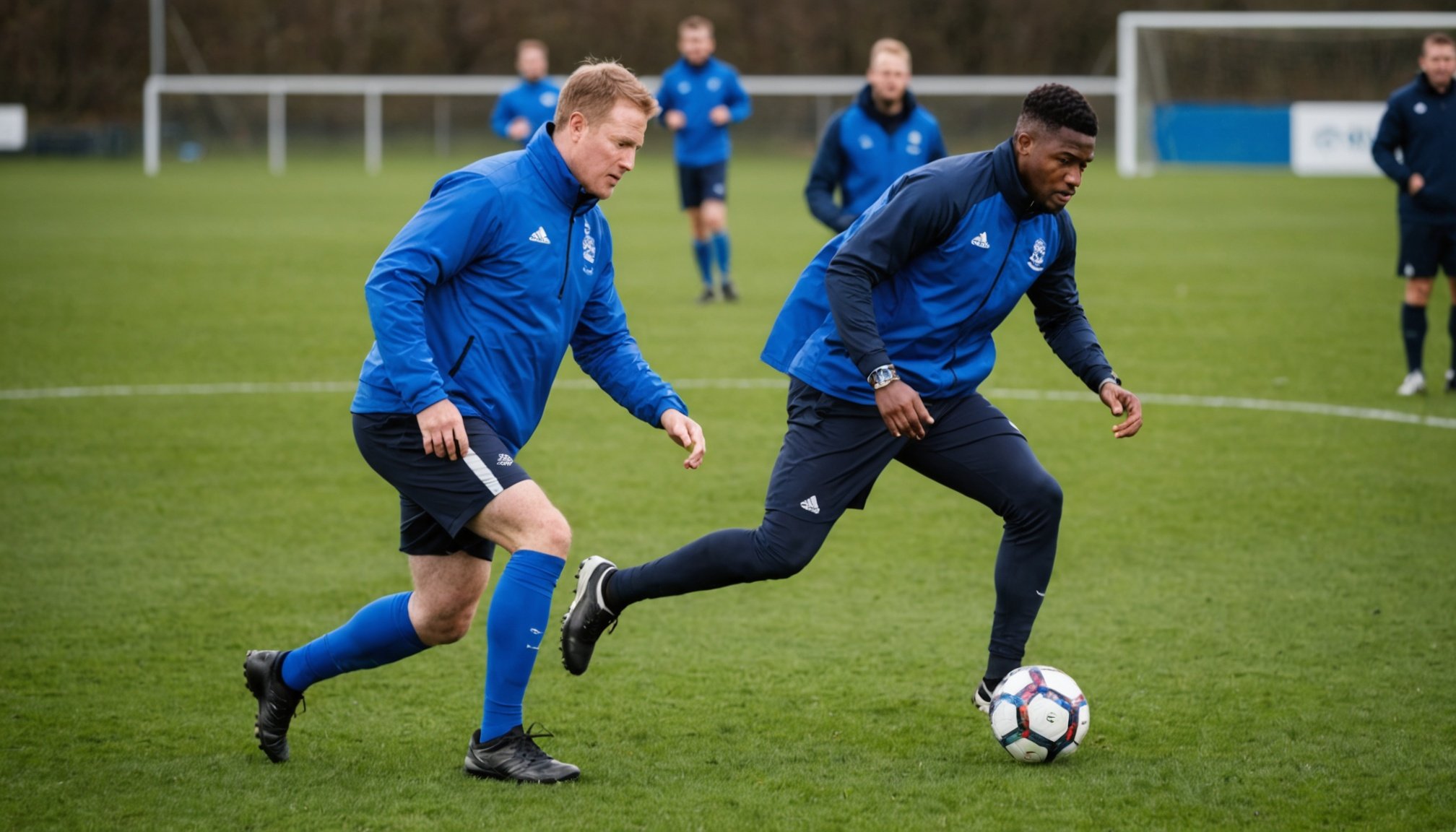Reviving the Game: Strategies for UK Football Coaches to Effectively Support Players Returning from Extended Injuries
Understanding the Challenge of Extended Injuries
When a football player suffers an extended injury, it can be a daunting and demoralizing experience, not just for the player, but also for the entire team and coaching staff. The road to recovery is often long and arduous, requiring a meticulous and well-structured approach to ensure the player returns to the pitch in optimal condition.
The Psychological Impact
Extended injuries can have a significant psychological impact on players. The loss of identity and the feeling of being disconnected from the team can lead to anxiety, depression, and a decreased motivation to return to training. Coaches play a crucial role in addressing these psychological aspects through regular communication, positive reinforcement, and involving the player in team activities even when they are not physically participating.
Also read : Boosting Football Players” Stamina: The Power of Periodized Training Programs
"Psychological support is just as important as physical rehabilitation. Keeping the player engaged and motivated is key to a successful return," says Dr. Emma Taylor, a sports psychologist specializing in athlete recovery.
Tailored Rehabilitation Programs
A tailored rehabilitation program is essential for ensuring a player’s safe and effective return to the game. Here are some key components to include:
Phase 1: Immediate Post-Injury Care
- Initial Assessment: Conduct a thorough assessment of the injury to determine the extent of the damage and create a personalized recovery plan.
- Pain Management: Use appropriate pain management strategies such as medication, physical therapy, and rest.
- Basic Mobility: Gradually introduce basic mobility exercises to maintain flexibility and prevent muscle atrophy.
Phase 2: Strengthening and Conditioning
- Resistance Training: Incorporate resistance exercises to strengthen the affected area and surrounding muscles.
- Cardiovascular Fitness: Use low-impact cardio exercises like cycling or swimming to maintain cardiovascular fitness without putting excessive stress on the injured area.
- Functional Training: Introduce functional training that mimics the movements and actions required in football, such as agility drills and plyometrics.
Phase 3: Sports-Specific Training
- Technical Drills: Gradually introduce sports-specific technical drills to improve skills such as dribbling, passing, and shooting.
- Tactical Training: Incorporate tactical training to help the player understand and execute team strategies.
- Full-Contact Training: Progress to full-contact training under the supervision of the coaching staff to ensure the player is ready for competitive matches.
Monitoring and Adjusting the Recovery Process
Effective monitoring and adjustment of the recovery process are critical to prevent setbacks and ensure a smooth transition back to competitive football.
Have you seen this : Unlocking Peak Performance: How Football Players Leverage Biofeedback for Enhanced Physiological Responses in Matches
Athlete Monitoring
- Regular Assessments: Conduct regular assessments to monitor the player’s progress, adjusting the rehabilitation plan as necessary.
- Technology Integration: Use advanced technologies such as GPS tracking, heart rate monitoring, and biomechanical analysis to gather detailed data on the player’s performance and recovery.
- Player Feedback: Encourage open communication with the player to understand their feelings and any concerns they may have.
"Technology has revolutionized athlete monitoring. It allows us to make data-driven decisions and tailor the recovery process to the individual needs of each player," explains Mark Jenkins, a sports scientist with a professional football club.
Recovery Strategies
Several recovery strategies can be employed to support players returning from extended injuries:
Water Immersion
- Cold Water Immersion: Cold water immersion (CWI) is a popular recovery technique that involves immersing the body in cold water to reduce muscle inflammation and improve recovery.
- Contrast Water Therapy: Contrast water therapy (CWT) involves alternating between hot and cold water to enhance blood flow and aid in the removal of waste products.
Active Recovery
- Light Exercise: Engage in light exercise such as cycling or jogging to promote blood flow and maintain cardiovascular fitness.
- Stretching and Foam Rolling: Incorporate stretching and foam rolling to improve flexibility and reduce muscle soreness.
Mental Recovery
- Mindfulness and Meditation: Encourage mindfulness and meditation practices to help manage stress and improve mental well-being.
- Visualization Techniques: Use visualization techniques to help the player mentally prepare for their return to the game.
Practical Insights and Actionable Advice
Here are some practical insights and actionable advice for coaches supporting players returning from extended injuries:
Building a Support Network
- Multidisciplinary Team: Work with a multidisciplinary team including physiotherapists, sports scientists, and psychologists to ensure a comprehensive approach to recovery.
- Family and Friends: Encourage the player to maintain a strong support network of family and friends to help cope with the psychological aspects of injury.
Setting Realistic Goals
- Short-Term Goals: Set short-term goals that are achievable and help the player stay motivated throughout the recovery process.
- Long-Term Goals: Establish long-term goals that align with the player’s overall career aspirations.
Staying Informed
- Google Scholar and PubMed: Utilize academic databases such as Google Scholar and PubMed to stay updated with the latest research on injury rehabilitation and recovery strategies.
- Professional Networks: Engage with professional networks and attend workshops to share best practices and learn from other coaches and sports scientists.
Case Studies and Examples
Robert Lewandowski’s Recovery
Robert Lewandowski, the Polish striker for FC Barcelona, is a prime example of how effective rehabilitation and support can lead to a successful return from injury. Despite facing a season without his best performances, Lewandowski has proven his resilience and adaptability, returning to his top form under the guidance of his coaching staff and support team[1].
The Hungarian Football Team’s Innovative Tactics
The Hungarian football team’s historic victory over England in 1953, despite being without their star player Ferenc Puskás, highlights the importance of tactical innovation and collective defense. This approach can be applied to supporting injured players by adjusting team strategies to compensate for their absence and ensuring a smooth transition upon their return[2].
Table: Comparative Analysis of Recovery Strategies
| Recovery Strategy | Benefits | Drawbacks | Examples |
|---|---|---|---|
| Cold Water Immersion | Reduces muscle inflammation, improves recovery | Potential for hypothermia, discomfort | Commonly used by professional football teams |
| Contrast Water Therapy | Enhances blood flow, aids in waste removal | Requires specific facilities, may be time-consuming | Used by athletes post-intense training sessions |
| Active Recovery | Promotes blood flow, maintains cardiovascular fitness | May exacerbate injury if not done correctly | Light jogging, cycling |
| Mental Recovery Techniques | Improves mental well-being, reduces stress | Requires commitment and practice | Mindfulness, meditation, visualization |
| Tailored Rehabilitation Programs | Personalized to the player’s needs, ensures safe return | Time-consuming, requires multidisciplinary team | Phase 1: Immediate post-injury care, Phase 2: Strengthening and conditioning |
Supporting players returning from extended injuries is a complex and multifaceted task that requires a holistic approach. By understanding the psychological impact, creating tailored rehabilitation programs, monitoring and adjusting the recovery process, and employing various recovery strategies, coaches can ensure a successful and sustainable return for their players.
Remember, every player’s journey is unique, and what works for one may not work for another. Staying informed through continuous education and leveraging the latest research are crucial in providing the best possible support.
"The key to successful recovery is patience, persistence, and a well-structured plan. Coaches must be adaptable and willing to adjust their strategies based on the player's progress," advises John Smith, a veteran football coach with extensive experience in player rehabilitation.






